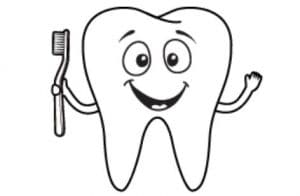Children’s Oral Health
Overview
Cavities (also known as caries or tooth decay) are the most common chronic disease of childhood in the United States1. Untreated cavities can cause pain and infections that may lead to problems with eating, speaking, playing, and learning. Children who have poor oral health often miss more school and receive lower grades than children who don’t.
- More than half of children aged 6 to 8 have had a cavity in at least one of their baby (primary) teeth.2
- More than half of adolescents aged 12 to 19 have had a cavity in at least one of their permanent teeth.2
- Children aged 5 to 19 years from low-income families are twice as likely (25%) to have cavities, compared with children from higher-income households (11%).3

Visit the Resources page for materials and information about children’s oral health
The good news is that cavities are preventable. Fluoride varnish can prevent about one-third (33%) of cavities in the primary (baby) teeth.4 Children living in communities with fluoridated tap water have fewer cavities than children whose water is not fluoridated.5 Similarly, children who brush daily with fluoride toothpaste will have fewer cavities.6
Dental sealants can also prevent cavities for many years. Applying dental sealants to the chewing surfaces of the back teeth prevent 80% of cavities.7
What Parents and Caregivers Can Do

For Babies
- Wipe gums twice a day with a soft, clean cloth in the morning after the first feeding and right before bed to wipe away bacteria and sugars that can cause cavities.
- When teeth come in, start brushing twice a day with a soft, small‑bristled toothbrush and plain water.
- Visit the dentist by your baby’s first birthday to spot signs of problems early.
- Talk to your dentist or doctor about putting fluoride varnish on your child’s teeth as soon as the first tooth appears.
For children younger than 2, consult first with your doctor or dentist regarding the use of fluoride toothpaste.

For Children
- Brush their teeth twice a day with fluoride toothpaste.
- Help your child brush their teeth until they have good brushing skills.
If your child is younger than 6, watch them brush. Make sure they use a pea-sized amount of toothpaste and always spit it out rather than swallow. - Ask your child’s dentist to apply dental sealants when appropriate.
- Drink tap water that contains fluoride.
To see if your community’s water is fluoridated, you can view your water system on CDC’s My Water’s Fluoride website.
You can also call your water utility company and request a copy of the utility’s most recent “Consumer Confidence Report.” This report provides information on the level of fluoride in your drinking (tap) water.
If your drinking water does not have enough fluoride to prevent cavities (the optimal amount of 0.7 milligrams per Liter), ask your dentist, pediatrician, family doctor, or nurse if your child needs oral fluoride supplements, such as drops, tablets, or lozenges.

Good Dental Health Is Important When Pregnant
When you’re pregnant, you may be more prone to gum disease and cavities, which can affect your baby’s health. Follow these 3 steps to protect your teeth:
- See a dentist (it’s safe!) before you deliver.
- Brush your teeth twice a day.
- Floss Daily.
If you have nausea, rinse your mouth with 1 teaspoon of baking soda in a glass of water after you get sick. This helps wash stomach acid away and keep your tooth enamel safe.
What Are the Risk Factors for Cavities?
Your child’s chance of getting cavities can be higher if:
- Family members (older brothers, sisters, or parents) have cavities.
- They eat and drink a lot of sugary foods and drinks, like soda, especially between meals.
- They have special health care needs.
- They wear braces or orthodontics or oral appliances.
If any of these apply to your child, be sure to talk with your dentist, pediatrician, or family doctor to make sure you are taking extra steps to protect your child’s teeth.
- American Academy of Pediatrics Protect Tiny Teeth for Providers: Resources for patient education and clinical resources to help integrate oral health into your practice.
- American Academy of Pediatrics Children’s Oral Health information: Resources and guidance to improve the oral health of children.
- Community Preventive Service Task Force Recommendations for Improving Oral Health: Evidence-based recommendations related to dental sealants, craniofacial injuries, community water fluoridation, and more.
- Oral Health and Learning [PDF-81KB]: A fact sheet on the impact of oral health on overall health and learning.
-
- American Academy of Pediatrics Protect Tiny Teeth: Oral health tips for pregnant women and new parents.
- American Academy of Pediatrics Healthychildren.org: General information related to child health and guidance on parenting issues.
- American Academy of Pediatric Dentistry My Children’s Teeth: Oral health resources for infancy through teenage years.
- American Dental Association Mouth Healthy: Information on how to keep parent’s and children’s mouths healthy.
- Infant Formula and Fluorosis: Frequently asked questions about infant formula and risk for dental fluorosis.
- Dental Sealants: Information about dental sealants, their benefits, and school sealant programs.
- National Institute of Dental and Craniofacial Research A Healthy Mouth for Your Baby: A brochure for parents of infants or toddlers explaining why baby teeth are important and how to prevent cavities.
- Text4Baby: A free text messaging service and cellphone app delivering oral health messages to pregnant women and new parents.
- CDC Kidtastics Smile: A podcast episode for children talking about how to keep their teeth and mouth healthy.